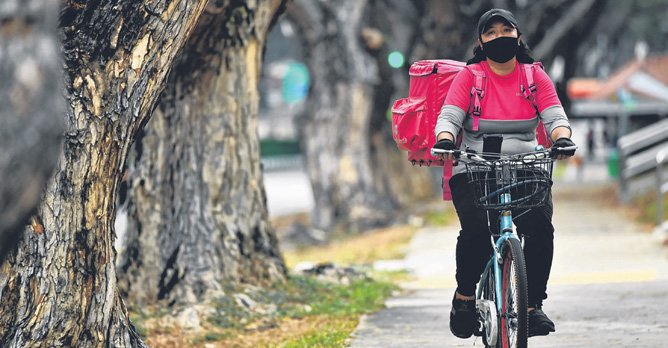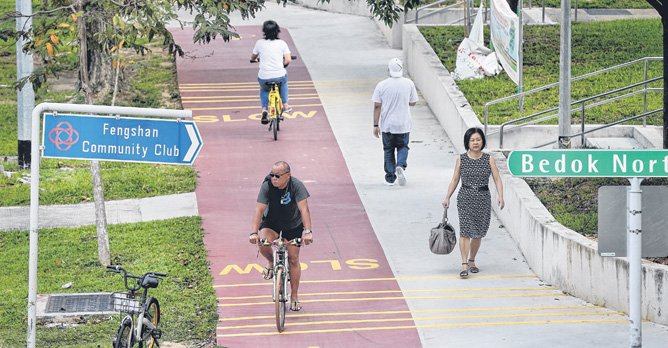Plans to expand cycling network could be sped up
18 Dec 2019|844 views
Plans to expand the cycling network threefold may be brought forward by a few years from an original 2030 target, in a move that could also give electric scooter users more room to ride.
Senior Minister of State for Transport Lam Pin Min said on 17 December 2019 that the new aim is to expand the network from 440km to about 1,300km earlier than targeted. This will not just promote active mobility, but also give more riding space to users whose e-scooters have been banned from footpaths.
"We are currently looking at the timeline. Hopefully, we will be able to bring it forward by a couple of years," said Dr. Lam, who added that the Government will look at the possibility of reclaiming roads to create space for cycling paths. He had earlier announced that the cycling network will be increased to 750km by 2025, and about 1,300km by 2030.
Riders of e-scooters were banned from the 5,500km of footpaths on 5 November 2019 and told to stick to cycling paths. Dr. Lam, who viewed active mobility infrastructure in Ang Mo Kio, also said the authorities are looking at how to speed up the conversion of footpaths to shared paths.
On expediting the plans, Dr Lam said, "We are doing this because, with the announcement of the ban of e-scooters on footpaths, the connectivity for active mobility users has been affected. I think (the footpath ban) is a necessary step to bring back safety to footpaths, but at the same time we are also working at increasing the connectivity and improving the active mo-bility infrastructure."

From 1 January 2020, those caught riding e-scooters on footpaths can be fined up to $2,000, jailed for up to three months, or both. The Land Transport Authority said earlier this month that it had issued 3,444 warnings to riders since the ban started.
There has been a "palpable difference" in terms of safety on footpaths since the e-scooter footpath ban kicked in, with pedestrians now likely to feel much safer, said Dr. Lam. Yesterday, he cycled a 5km-long route in Ang Mo Kio, together with Transport Minister Khaw Boon Wan, fellow Senior Minister of State for Transport Janil Puthucheary and Active Mobility Advisory Panel Chairman Faishal Ibrahim.
Ang Mo Kio was designated as a walking and cycling town in 2014, with features implemented to let pedestrians and active mobility users use paths safely.
There will be 20km of cycling paths in Ang Mo Kio by 2022, which would make the network one of the longest in residential towns in Singapore. This has been facilitated through wider zebra crossings, bicycle crossings and a new digital display counter that shows the number of pedestrians and cyclists on the paths along Ang Mo Kio Avenue 3.
Ang Mo Kio town's active mobility infrastructure could be a role model for others, said Dr. Lam, "Hopefully we will be able to build more conducive cycling paths and active mobility infrastructure for Singaporeans in every town in Singapore."
Plans to expand the cycling network threefold may be brought forward by a few years from an original 2030 target, in a move that could also give electric scooter users more room to ride.
Senior Minister of State for Transport Lam Pin Min said on 17 December 2019 that the new aim is to expand the network from 440km to about 1,300km earlier than targeted. This will not just promote active mobility, but also give more riding space to users whose e-scooters have been banned from footpaths.
"We are currently looking at the timeline. Hopefully, we will be able to bring it forward by a couple of years," said Dr. Lam, who added that the Government will look at the possibility of reclaiming roads to create space for cycling paths. He had earlier announced that the cycling network will be increased to 750km by 2025, and about 1,300km by 2030.
Riders of e-scooters were banned from the 5,500km of footpaths on 5 November 2019 and told to stick to cycling paths. Dr. Lam, who viewed active mobility infrastructure in Ang Mo Kio, also said the authorities are looking at how to speed up the conversion of footpaths to shared paths.
On expediting the plans, Dr Lam said, "We are doing this because, with the announcement of the ban of e-scooters on footpaths, the connectivity for active mobility users has been affected. I think (the footpath ban) is a necessary step to bring back safety to footpaths, but at the same time we are also working at increasing the connectivity and improving the active mo-bility infrastructure."

From 1 January 2020, those caught riding e-scooters on footpaths can be fined up to $2,000, jailed for up to three months, or both. The Land Transport Authority said earlier this month that it had issued 3,444 warnings to riders since the ban started.
There has been a "palpable difference" in terms of safety on footpaths since the e-scooter footpath ban kicked in, with pedestrians now likely to feel much safer, said Dr. Lam. Yesterday, he cycled a 5km-long route in Ang Mo Kio, together with Transport Minister Khaw Boon Wan, fellow Senior Minister of State for Transport Janil Puthucheary and Active Mobility Advisory Panel Chairman Faishal Ibrahim.
Ang Mo Kio was designated as a walking and cycling town in 2014, with features implemented to let pedestrians and active mobility users use paths safely.
There will be 20km of cycling paths in Ang Mo Kio by 2022, which would make the network one of the longest in residential towns in Singapore. This has been facilitated through wider zebra crossings, bicycle crossings and a new digital display counter that shows the number of pedestrians and cyclists on the paths along Ang Mo Kio Avenue 3.
Ang Mo Kio town's active mobility infrastructure could be a role model for others, said Dr. Lam, "Hopefully we will be able to build more conducive cycling paths and active mobility infrastructure for Singaporeans in every town in Singapore."
Latest COE Prices
August 2025 | 2nd BIDDING
NEXT TENDER: 03 Sep 2025
CAT A$104,524
CAT B$124,400
CAT C$72,190
CAT E$125,001
View Full Results Thank You For Your Subscription.






















